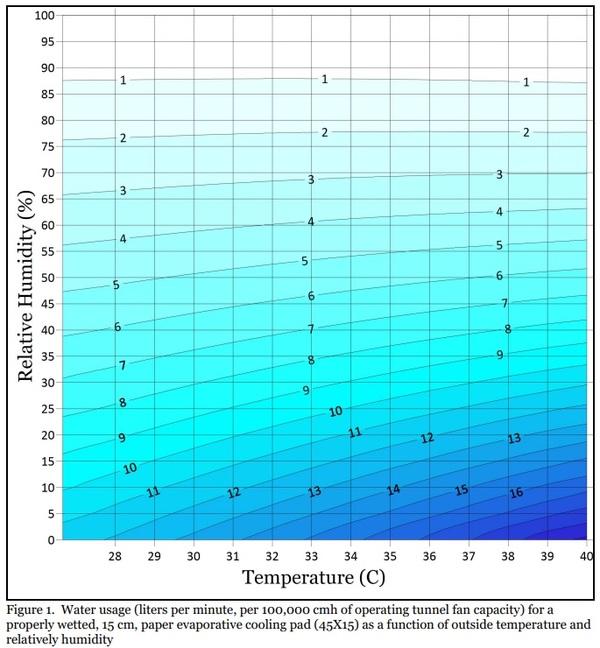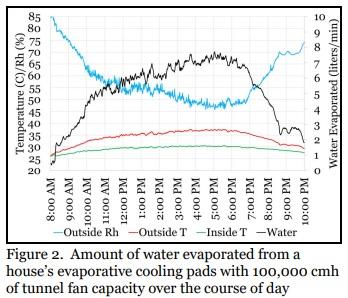Evaporative Cooling Pad Water Usage Chart
Published: September 1, 2022
By: Michael Czarick / Department of Poultry Science - University of Georgia.

Figure 1 illustrates the amount of water which will evaporate from properly wetted, 15 cm paper evaporative cooling pad system, as a function of outside temperature and relative humidity. The amount of water evaporated is provided in terms of gallons per minute per 100,000 cmh of operating tunnel fan capacity. For example, if a house had 100,000 cmh of tunnel fan capacity and the outside temperature were 32°C with a relative humidity 60%, approximately 4 liters of water would evaporate from the house’s pad system each minute. If the house had 200,000 cmh of tunnel fan capacity, 8 liters of water [2 (100,000 cfm) X 4 liters/min] would evaporate from the pads each minute. If the outside relative humidity were lower (20% vs 60%), the amount of cooling produced by the pads would increase from 5°C to 11°C (Poultry Housing Tips. Volume 34 Number 10 - metric. Evaporative Cooling Pad Performance Charts) and in turn, water usage would increase roughly proportionally from 8 to 20.4 gallons per minute [2 (100,000 cmh) x 10.2 liters/min].
The precise amount of cooling, and therefore water usage, produced by any evaporative cooling pad will vary with how thoroughly a pad is wetted as well as its age. If significant portions of the pad are dry, the cooling produced will be lower and, in turn, water usage will be lower. As pads get older, dirt, small feathers, and minerals collecting on pad surfaces tend to increase the surface area of the pad, resulting in slightly increased cooling and therefore a slight increase in pad water usage.
Though the chart was developed assuming that all a house’s tunnel fans are operating and the house’s evaporative cooling pad area is properly sized (one square meter of pad per 6,500 cmh of tunnel fan capacity), interestingly, operating a fraction of a house’s tunnel fan capacity wouldn’t significantly increase the amount of cooling produced by a pad system and therefore the predicted water usage from the Figure 1 remains accurate. For instance, if a house has enough evaporative cooling pad for ten fans (340,000 cmh) and only seven are operating, (240,000 cmh) even though the incoming air would move more slowly through the pads, the amount of cooling produced by the pad system would only increase by less than a quarter a degree and as a result water usage per 100,000 cmh would not increase significantly.
The relationship between the amount of cooling produced by an evaporative cooling system and the resulting water usage is very predictable. For every one degree of cooling produced, approximately 1.1 liters/min will evaporate from a house’s evaporative cooling pads for every 100,000 cmh of operating tunnel fan capacity. For example, if a house has 300,000 cmh of tunnel fan capacity and the pad system is producing 10°C cooling, approximately 33 liters/min will evaporate from the pads each minute [1.1 liters/min X 10°C X 3 (100,000 cmh)]. More cooling, more water. Less cooling, less water.

BPad system water usage will vary significantly throughout the day because the outside temperature and relative humidity will vary throughout the day. As the outside temperature increases, the relative humidity decreases and the amount of cooling produced by a pad system increases, which means more water will evaporate from the pads (Figure 2). As a result, it’s not uncommon for the amount of water used by a pad system to change three- to fivefold over the course of the day. If the number fans operating changes over the course of the day, the variation in water usage will be even greater.
This article was originally published in Poultry Housing Tips, Volume 34, Number 11, 2022. University of Georgia, College of Agricultural and Environmental Sciences Cooperative Extension (https://www.poultryventilation.com/).
Related topics
Authors:
University of Georgia
Recommend
Comment
Share
2 de noviembre de 2022
Nice information by Dr. Mike Czarick,
The potential for evaporative cooling depends on the difference in wet bulb and dry bulb temperatures of the air. Humid air has a high relative humidity, and not as much capability to evaporate moisture. As the relative humidity of the air increases, the performance of the system will decrease, limiting its application in moist climates. Evaporative cooling is most effective in climates where average relative humidity is less than 30%. As humidity increases, and the cooling capability declines, the temperature difference between the outside and inside of the chamber decreases. To test if evaporative cooling will be effective, the wet bulb temperature can be measured by placing a moist cloth on the end of a thermometer and waving it through the air. The temperature read by the thermometer is the theoretical minimum temperature that can be achieved through evaporative cooling. For a visual representation of this phenomenon we can use psychometric charts. psychometric charts are a useful tool for predicting a particular wet-bulb temperature given the outside ambient conditions: pressure, temperature, and humidity.
Above and beyond pyschometric charts (which only have 3 variables), anything that increases the rate of evaporation of a system will make evaporative cooling more effective.
This includes:
Lowering ambient humidity
Decreasing atmospheric pressure
Increasing ambient temperature (though this one is obviously counterproductive)
Increasing surface area of evaporation
Choosing different evaporative media
Adding air movement/wind
Using all of these variables we are able to optimize the cooling effect of our system across the widest range of applications.
Recommend
Reply

Would you like to discuss another topic? Create a new post to engage with experts in the community.










.jpg&w=3840&q=75)